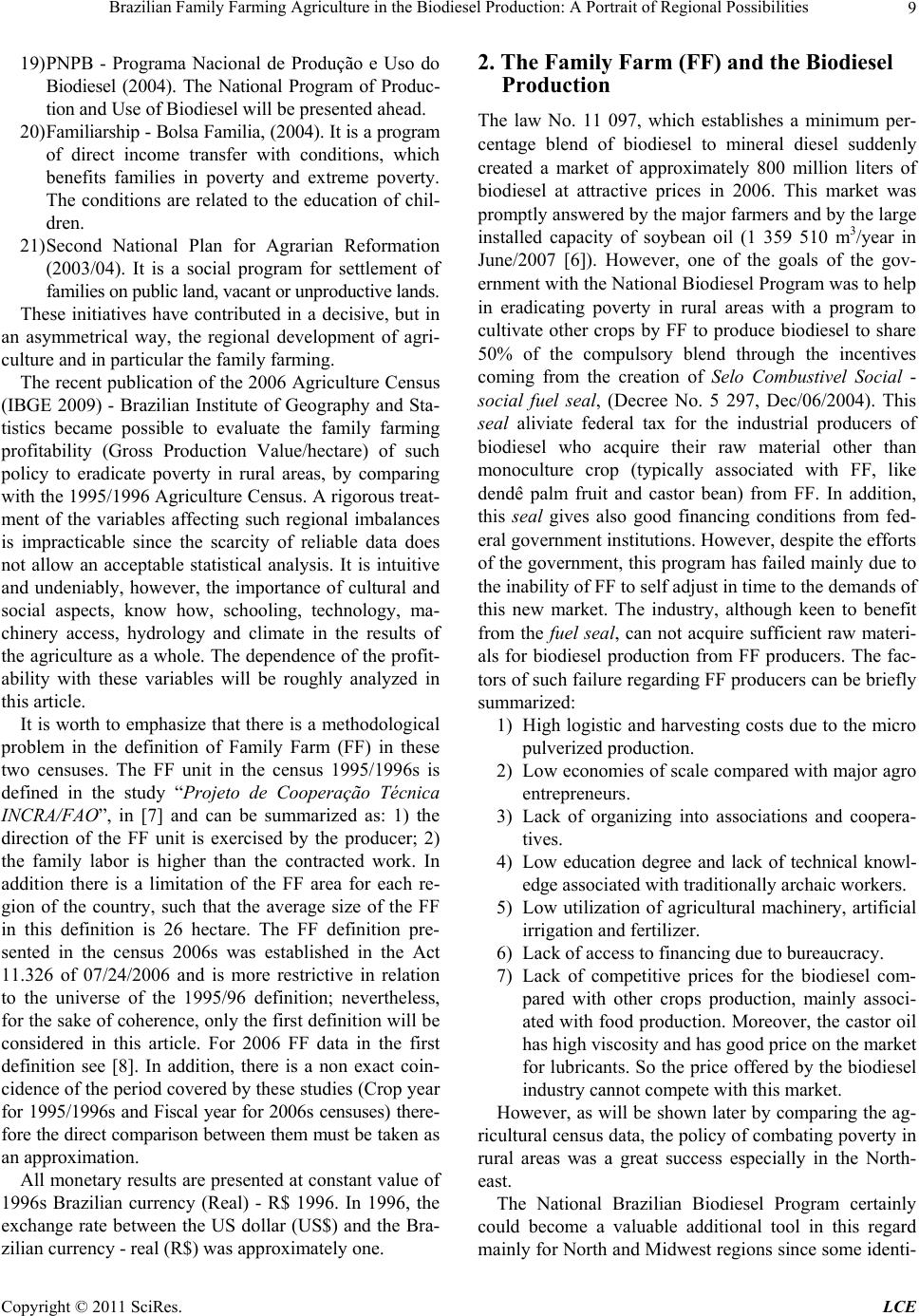
Brazilian Family Farming Agriculture in the Biodiesel Production: A Portrait of Regional Possibilities9
19) PNPB - Programa Nacional de Produção e Uso do
Biodiesel (2004). The National Program of Produc-
ti o n and Use of Biodiesel will be presented ahead.
20) Familiarship - Bolsa Familia, (2004). It is a program
of direct income transfer with conditions, which
benefits families in poverty and extreme poverty.
The conditions are related to the education of chil-
dren.
21) Second National Plan for Agrarian Reformation
(2003/04). It is a social program for settlement of
families on public land, vacant or unproducti ve lands.
These initiatives have contributed in a decisive, but in
an asymmetrical way, the regional development of agri-
culture and in particular the family farming.
The recent publication of the 2006 Agriculture Census
(IBGE 2009) - Brazilian Institute of Geography and Sta-
tistics became possible to evaluate the family farming
profitability (Gross Production Value/hectare) of such
policy to eradicate poverty in rural areas, by comparing
with the 1995/1996 Agriculture Census. A rigorous treat-
ment of the variables affecting such regional imbalances
is impracticable since the scarcity of reliable data does
not allow an acceptable statistical analysis. It is intuitive
and undeniably, however, the importance of cultural and
social aspects, know how, schooling, technology, ma-
chinery access, hydrology and climate in the results of
the agriculture as a whole. The dependence of the profit-
ability with these variables will be roughly analyzed in
this article.
It is worth to emphasize that there is a methodological
problem in the definition of Family Farm (FF) in these
two censuses. The FF unit in the census 1995/1996s is
defined in the study “Projeto de Cooperação Técnica
INCRA/FAO”, in [7] and can be summarized as: 1) the
direction of the FF unit is exercised by the producer; 2)
the family labor is higher than the contracted work. In
addition there is a limitation of the FF area for each re-
gion of the country, such that the average size of the FF
in this definition is 26 hectare. The FF definition pre-
sented in the census 2006s was established in the Act
11.326 of 07/24/2006 and is more restrictive in relation
to the universe of the 1995/96 definition; nevertheless,
for the sake of coherence, only the first definition will be
considered in this article. For 2006 FF data in the first
definition see [8]. In addition, there is a non exact coin-
cidence of the period covered by these studies (Crop year
for 1995/1996s and Fiscal year for 2006s censuses) there-
fore the direct comparison between them must be t ake n as
an approximation.
All monetary results are presented at con stant value of
1996s Brazilian currency (Real) - R$ 1996. In 1996, the
exchange rate between the US dollar (US$) and the Bra-
zilian currency - real (R$) was approximately one.
2. The Family Farm (FF) and the Biodiesel
Production
The law No. 11 097, which establishes a minimum per-
centage blend of biodiesel to mineral diesel suddenly
created a market of approximately 800 million liters of
biodiesel at attractive prices in 2006. This market was
promptly answered by the major farmers and by the large
installed capacity of soybean oil (1 359 510 m3/year in
June/2007 [6]). However, one of the goals of the gov-
ernment with the National Biodiesel Program was to help
in eradicating poverty in rural areas with a program to
cultivate other crops by FF to produce biodiesel to share
50% of the compulsory blend through the incentives
coming from the creation of Selo Combustivel Social -
social fuel seal, (Decree No. 5 297, Dec/06/2004). This
seal aliviate federal tax for the industrial producers of
biodiesel who acquire their raw material other than
monoculture crop (typically associated with FF, like
dendê palm fruit and castor bean) from FF. In addition,
this seal gives also good financing conditions from fed-
eral government institutio ns. However, despite th e effo rts
of the government, this program has failed mainly due to
the inability of FF to self adjust in time to the demands of
this new market. The industry, although keen to benefit
from the fuel seal, can not acquire sufficient raw materi-
als for biodiesel production from FF producers. The fac-
tors of such failure regarding FF producers can be briefly
summarized:
1) High logistic and harvesting costs due to the micro
pulverized produc t ion.
2) Low economies of scale compared with major agro
entrepreneurs.
3) Lack of organizing into associations and coopera-
tives.
4) Low education degree and lack of technical knowl-
edge associated with traditionally archaic workers.
5) Low utilization of agricultural machinery, artificial
irrigation and fertilizer.
6) Lack of access to financing due to bureaucracy.
7) Lack of competitive prices for the biodiesel com-
pared with other crops production, mainly associ-
ated with food production. Moreover, the castor oil
has high viscosity and has good price on the market
for lubricants. So the price offered by the biodiesel
industry cannot compete with this market.
However, as will be shown later by comparing th e ag-
ricultural census data, the policy of combatin g poverty in
rural areas was a great success especially in the North-
east.
The National Brazilian Biodiesel Program certainly
could become a valuable additional tool in this regard
mainly for North and Midwest regions since some identi-
Copyright © 2011 SciRes. LCE